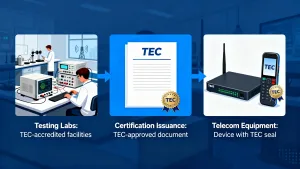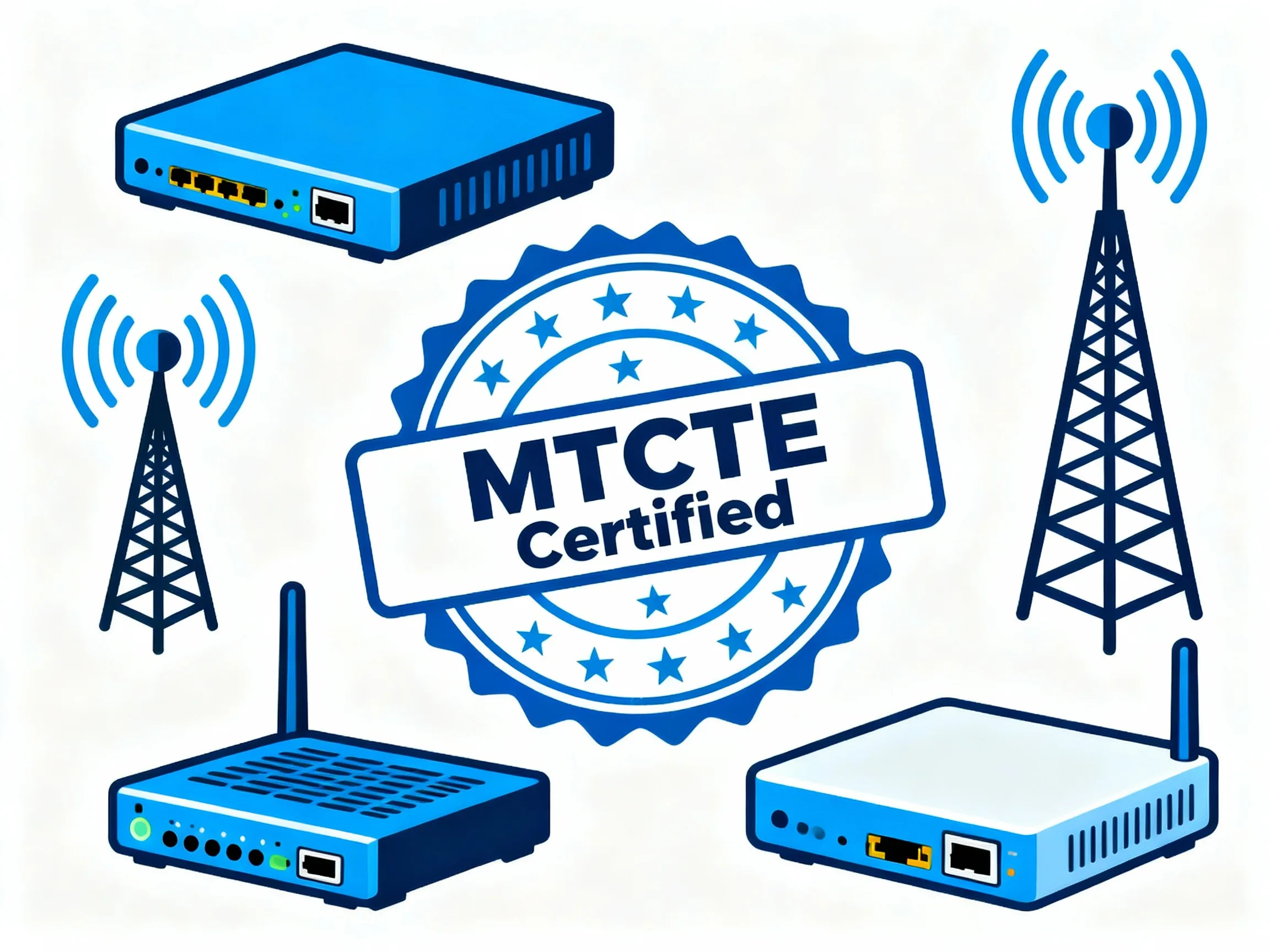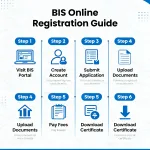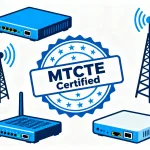What is MTCTE and why does MTCTE certificate matter for telecom equipment
MTCTE stands for mandatory testing and certification of telecom equipment. It is the mechanism through which the government of India ensures that every telecom product introduced for use in India meets prescribed standards. When a router. a base station. a handset or any piece of telecom equipment is sold in India. it must be safe for networks and users. MTCTE certification was created to ensure devices do not cause harmful interference. do not exceed radio frequency limits. and comply with essential requirements that protect public communication networks.
The telecommunication engineering center or TEC evaluates whether equipment meets these essential requirements and issues a TEC certificate when the product passes conformity assessment. The MTCTE scheme is not paperwork for its own sake. It is about conformance and about keeping existing network performance and public safety intact. Think of it as quality insurance for the communications that connect daily life.
1. What exactly is the MTCTE Certificate scheme and why does it exist?
The term MTCTE stands for Mandatory Testing and Certification of Telecom Equipment. This isn’t optional anymore for certain telecommunication gear if the product is to be sold or used in India. The certification of telecom equipment under MTCTE ensures that the equipment meets the parameters laid down by the Telecommunication Engineering Centre (TEC) under the Department of Telecommunications.
Why was it needed? On the face of it, there are a few strong reasons:
-
To ensure that any equipment connected to public networks in India does not degrade performance of the existing network.
-
To ensure the safety of end-users and the general public via controlling radio-frequency emissions, EMI/EMC and technical parameters.
-
To make sure telecom equipment complies with both relevant national and international regulatory standards.
So if you are dealing with telecom product design, import or sales in India, you cannot ignore MTCTE. It is a certification scheme you must engage with as part of your entry strategy.
2. How does the Telecommunication Engineering Centre (TEC) fit into this certification process?
The Telecommunication Engineering Centre (TEC) is the nodal body under the Department of Telecommunications (DoT), Ministry of Communications. It draws up standards (Generic Requirements, Interface Requirements, Service Requirements) for telecom products, and administers the certification programme.

Within the MTCTE framework, TEC issues the actual certificate (often referred to as MTCTE certificate or TEC certificate) after the testing and conformity assessment by designated labs.
In simpler words: your telecom equipment must be tested (by accredited labs) for the essential requirements laid down by TEC; TEC then evaluates and issues a certificate via the MTCTE portal. Without that certificate, the equipment cannot be legally sold or used in India.
3. Which telecom equipment must undergo this mandatory testing and certification?
The rule is quite clear: “Every telecom equipment must undergo mandatory testing and certification prior to sale, import or use in India.”
However, in reality, the MTCTE scheme covers notified products in phases (Phase-I, Phase-II, etc) depending on product categories. Examples of telecom equipment include routers, switches, modems, IP-based devices, optical transport equipment, customer premises equipment (CPE), etc.
So if you are manufacturing or importing equipment which connects to public telecom networks (wired or wireless), chances are you will fall under MTCTE. The challenge is identifying if your particular model is under a “notified equipment in India” list and whether it must undergo mandatory testing.
4. What are the essential requirements and conformity assessment criteria under MTCTE?
When we talk about essential requirements (ERs) under MTCTE: these are the technical, safety, electromagnetic compatibility (EMC/EMI), radio-frequency (RF) and interface requirements that the equipment must meet.
In the conformity assessment process:
-
The equipment must comply with the parameters specified in the essential requirements in accordance with the parameters laid out by TEC.
-
Testing is carried out by labs designated by TEC (or imported if from an ILAC-signatory lab under certain conditions) for the test report.
-
The applicant must submit evidence (test report, compliance sheet etc) and then TEC evaluates and issues a certificate.
There is also a concept of conformity assessment bodies, recognized labs, mutual recognition (MRA) for partner countries in some cases.
In short: your equipment must not only function but must meet the official requirements so that it is safe, compatible with networks, and meets regulatory standards.
5. How does the step-by-step certification process (MTCTE procedure) work, practically?
Let us walk through the process as if you are the manufacturer or importer. The MTCTE procedure (for example TEC 93009:2024) lays out the stages.
Main steps:
-
Register on the MTCTE portal (the application interface) as an Applicant / OEM / Authorized Indian Representative (AIR).
-
Profile registration: Manufacturer (OEM) or Importer must create their profile.
-
Product details & Bill of Materials (BoM) for pre-check: you must submit your product model, configuration, variants, etc.
-
Send samples to a TEC-designated laboratory (Conformity Assessment Body) for testing in accordance with the Essential Requirements. The lab issues a test report.
-
Upload the test report, compliance sheet (or Self-Declaration in some schemes) and required documentation via the MTCTE portal.
-
Pay requisite fees and wait for evaluation by TEC. After satisfactory review, TEC issues the MTCTE certificate (or TEC certificate) which allows the equipment to be marketed, sold and used in India.
Note: The certificate is valid for a defined period (often 10 years) unless cancelled.
As someone involved in this process, you must treat this like a project: allow time for sample testing, documentation gathering, variant management, liaison with lab and portal submission.
6. What are the certification schemes available: General Certification Scheme (GCS) versus Simplified Certification Scheme (SCS)?
Not all equipment requires the same depth of review. Under MTCTE the certification of telecom equipment can be handled under different schemes depending on risk, complexity and variant types. For example:
-
The General Certification Scheme (GCS) is the default where full test reports from designated labs are needed, along with compliance documentation.
-
The Simplified Certification Scheme (SCS) applies to lower-risk, less complex devices where the applicant may submit a Self-Declaration of Conformity (SDoC) along with a compliance sheet instead of full test report evaluation.
Which scheme your telecom equipment falls under depends on the list of products and the “phase” under which the product category has been notified. The list of products determines whether your product is under GCS or SCS.
So you will want to check the “list of products” that the MTCTE scheme has notified and whether your model falls under GCS or SCS—and thereby plan your timeline and budget accordingly.
7. What is the role of the test report, accredited labs, and the MTCTE portal?
The test report is the backbone. Without it your certification cannot proceed. The report must come from an accredited laboratory or a lab designated by TEC.
Accredited labs/TEC-designated labs (Conformity Assessment Bodies or CABs) are crucial. The testing is performed in these labs according to the Essential Requirements (ERs) and relevant test conditions.
MTCTE portal is where you submit your application, track status, upload documents and review the list of certified equipment.
Put simply: pick a good accredited lab early, ensure your product is ready for testing (BOM, variants, part numbers), conduct tests, receive test report, submit through portal, and follow up. Miss any one of these steps and you will hit obstacles.
8. How does an importer or manufacturer engage: profiles, authorized Indian representative and equipment in India?
If you are an importer or foreign OEM, you will be required to engage an Authorized Indian Representative (AIR) who is responsible for dealings with TEC under the MTCTE certification scheme.
If you are an Indian manufacturer (OEM) you register your profile, submit your company details, contact details, factory info. Then you follow the product-registration route. The equipment you produce is “telecom equipment in India” and must comply with MTCTE.
When your product model is certified, you get a “valid certificate” issued by TEC (often referred to as MTCTE certificate or TEC certificate) which you must display (through the certification label) on the product or packaging as per TEC norms.
One important compliance point: your equipment must have the certification prior to sale, import or use in India under the Indian Telegraph (Amendment) Rules.
Also your listing must match the model details, part numbers and BoM that were submitted; any major deviation may raise non-compliance issues.
9. What common pitfalls, costs, and strategic tips should you know when pursuing the certification?
Since I have seen many manufacturers and importers stumble, here are some real-world pitfalls and strategic tips:
-
Pitfall: Underestimating the variety of variants. Many think “one test report covers all” but if you have multiple configurations or BoM variants then each may require separate review.
-
Pitfall: Choosing a non-designated lab. Using a lab that is not recognized by the TEC will invalidate the test report. Only labs designated by TEC (CABs) or under ILAC/MRA (depending) may be accepted.
-
Pitfall: Ignoring changes mid-life. If you make changes to the product after certification (e.g., firmware, radio frequency parameters, variant), you might trigger the need for additional testing or an associated-model addition.
-
Pitfall: Labeling errors. The certification label must match the model number, the certificate number must be clearly associated and the product must carry that mark. Without it customs or service providers may reject.
-
Cost & Timing: Certification time can vary; in the Legal broker guide they estimate 4-8 weeks in many cases. Budget may include application fees, lab test fees, possibly travel or sample shipping, variant extensions.
-
Strategic Tip: Engage the lab and check the Essential Requirements applicable to your product early. Some test parameters are heavy (EMI/EMC, Safety, RF) so plan cost and sample build accordingly.
-
Strategic Tip: Check the “list of products” and see under which Phase your product falls – this affects the scheme (GCS vs SCS), fees, and timing.
-
Strategic Tip: Consider future versions and variants – plan a “family model” approach so you can add associated models later without re-doing the full cycle.
-
Strategic Tip: Keep documentation ready: BoM, user manual, interface requirements, test setup details. The better your submission, faster the evaluation.
10. What does the future look like: security certification, mutual recognition, and updates to scope?
The regulatory landscape keeps evolving. For example: the MTCTE portal shows updates such as acceptance of ILAC test reports, security certification under the scheme for ONT/OLT, and new “Telecommunications (Framework to Notify Standards, Conformity Assessment and Certification) Rules, 2025”.
What this means for you:
-
Security certification of telecommunication equipment is gaining prominence (thinking cyber-security, network integrity).
-
Mutual recognition (MRA) of partner country test reports may ease burdens, but you must check current notifications.
-
The list of products covered under MTCTE continues to expand — so something that was voluntary may become mandatory. Staying ahead is wise.
In summary, what once may have been an optional certification regime is now a robust mandatory compliance engine for telecom equipment in India. If you position yourself smartly you turn this requirement into a market-access enabler, not a road-block.
Key Takeaways
-
The MTCTE scheme mandates that every piece of telecom equipment covered under the list must undergo mandatory testing and certification prior to sale, import or use in India.
-
The Telecommunication Engineering Centre (TEC) under the Department of Telecommunications is the authority issuing the certificates once the equipment meets the essential requirements.
-
The scheme covers many categories of telecom equipment, especially those interfacing with public networks or enabling connectivity.
-
You will need to use TEC-designated labs, produce a valid test report, submit via the MTCTE portal, and obtain a TEC certificate (often called MTCTE certificate).
-
Choosing between the General Certification Scheme (GCS) and the Simplified Certification Scheme (SCS) depends on your product’s complexity and risk level.
-
Avoid common pitfalls by early planning, correct labeling, variant management, and clear documentation.
-
Keep an eye on regulatory updates because the scope of mandatory testing and certification is expanding, including security certification and mutual recognition channels.
Who needs MTCTE certification and when must equipment undergo mandatory testing and certification
Every telecom equipment that will be used or sold in India must undergo mandatory testing and certification in many product categories. Manufacturers and importers must carefully check the MTCTE list of products to see whether a given telecom product is covered. Telecom equipment that connects to public networks or uses radio frequency generally falls within scope.
If you manufacture telecom equipment abroad and plan to import for sale or use in India….. you are the applicant and you must provide test reports from labs designated by TEC or labs that are accredited and recognized under MTCTE scheme. Service providers also demand a valid certificate from suppliers before approving equipment in the existing network. If equipment is not certified….. it can be barred from sale and deployment.
The departmental framework works with the department of telecommunications and the ministry of communications to enforce this requirement. The intent is simple….. protect the network and the people who rely on it.
How does the MTCTE procedure work on the MTCTE portal
The MTCTE portal is the digital interface where applicants submit their request for certification. First you create an account and then you choose the appropriate certification scheme that fits your product. The portal asks for product details….. technical documents….. and test reports. You upload test report files and the compliance sheet along with the service description.
The telecommunication engineering center evaluates the dossier. TEC may ask for clarifications….. may require additional tests….. or designate a TEC-designated lab to verify specific parameters. When the evaluation is complete and the product conforms with relevant national and international regulatory standards and requirements….. TEC issues the MTCTE certificate. That document confirms a valid certificate has been issued by TEC and that the product may be used in India.
The MTCTE portal timeline varies by product complexity and by how well the applicant prepares the documentation. A complete file and a recognized test report speed up the process. The portal also allows tracking of the certification process which helps manufacturers and importers plan market entry.
What tests are carried out in a laboratory and how to get a test report
Testing is at the heart of testing and certification of telecom equipment. Labs designated by TEC or other accredited labs will test for radio frequency emissions….. safety requirements….. electromagnetic compatibility and interface requirements with the network. The goal is to ensure equipment does not exceed prescribed emissions from equipment and that it conforms with conformance criteria.
A test report is the laboratory document that proves the product was tested and lists measured results. Applicants must provide a test report along with the compliance sheet and other supporting documents. For many products a test report from an ILAC recognized laboratory helps because ILAC accreditation signals international competence and facilitates mutual recognition arrangements or MRA with partner country labs.
If a product must undergo mandatory testing and certification then getting a reliable test report early will prevent delays. Labs designated by TEC have clear test specifications and many test houses now publish pre-test packages so manufacturers can self-test before formal submission.
What are the certification schemes available under MTCTE and which one is for you
MTCTE covers several certification schemes designed to match different business realities. There is a general certification scheme that applies to complex telecom equipment and a simplified certification scheme for lower risk products. In some cases there is self-declaration of conformity for well defined categories where risks are small and controlled.
Choosing the right certification scheme depends on the product risk profile….. whether the product needs radio frequency testing….. and whether mutual recognition is available with a partner country. The simplified schemes reduce time to market for manufacturers who can meet the essential requirements reliably. The general certification scheme requires more documentation and often more laboratory verification.
Understanding which scheme applies will save cost and time. The MTCTE portal usually indicates the recommended path and the telecommunication engineering center can clarify if the product classification is ambiguous.
How does TEC certification relate to MTCTE and the telecommunication engineering center role
TEC is the authority that evaluates the technical compliance of telecom equipment. The terms TEC certification and MTCTE certification are often used together because TEC issues the certificate used for mandatory testing and certification. The telecommunication engineering center tests the product parameters and takes decisions that are then reflected in the certificates.
TEC-designated labs are part of the ecosystem….. they are the laboratories recognized by the telecommunication engineering center to perform required tests. The TEC certificate is the document that an applicant receives once the product is evaluated and found to meet national and international regulatory standards and requirements. TEC issues the conformity assessment decision and publishes that decision on the MTCTE portal.
If a product is to be used in India then an issued by TEC certificate is often mandatory prior to sale. This is enforced by customs and the market regulators who check for valid certification in the supply chain.
How to prepare documentation and the compliance sheet that helps certification progress
Documentation matters more than one imagines. Prepare a clear compliance sheet that maps each requirement to the corresponding test result in the test report. The compliance sheet tells the evaluator which clause from the relevant standard is met and where to find evidence in the test report. Without this mapping even a full test report can be confusing.
Applicants must include product manuals….. interface requirements….. block diagrams and the test report. The compliance sheet along with the sdoc when applicable speeds evaluation. Be candid about variant models and whether original equipment is a reference design. Applicants must also specify which features will be enabled in the shipped product.
A well prepared dossier reduces queries from TEC and helps issue a valid certificate faster. Remember that TEC issues a TEC certificate only after it is satisfied the equipment complies with essential requirements and testing is carried in accordance with the parameters specified.
How security certification and ERS rules affect telecom product approvals
Security certification is increasingly part of the MTCTE discussion. Equipment that impacts network security or handles sensitive data may require additional security certification or evaluation under ERS rules. The scope includes both hardware and firmware assessments that ensure devices do not introduce vulnerabilities into the telecommunications ecosystem.
Service providers and the government both have an interest in ensuring security certification is robust because the cost of a security incident is high. Some products require both functional testing and security evaluation before TEC certification is granted. Manufacturers should plan for this and include security documentation early in the submission.
When in doubt consult the telecommunication engineering center guidelines and seek pre-submission consultations with recognized CAB or TEC-designated labs to avoid surprises.
How accredited labs and ILAC recognition help simplify certification for the Indian market
Accredited labs bring credibility. TEC-designated labs and accredited labs that are ILAC recognized provide test reports that are accepted more readily. Mutual recognition arrangements make it simpler to use accepted international reports for testing and certification of telecommunication equipment.
If your test report comes from a lab with ILAC accreditation it may reduce additional testing requirements since the test methods and measurement uncertainty are understood. That said TEC evaluates each submission on its merits and may request additional testing in a TEC-designated laboratory when needed.
Choosing an accredited laboratory early can reduce iterations and help obtain a valid certificate faster. Accredited testing also helps manufacturers demonstrate that their products meet national and international regulatory standards and requirements.
Common pitfalls manufacturers and importers face when seeking MTCTE certification
One common pitfall is poor documentation. Applicants submit test report files without a mapped compliance sheet and then are surprised by multiple clarifications. Another pitfall is assuming a foreign test report will be sufficient without checking ILAC recognition or TEC acceptance.
A third mistake is ignoring security certification needs. Devices with advanced network functions require a security evaluation and not accounting for that early leads to project delays. Finally, some applicants forget to check the MTCTE list of products and try to use a self-declaration route when the product must undergo mandatory testing and certification.
Manufacturers and importers should engage with TEC-designated labs early….. prepare a transparent conformity assessment file….. and use the MTCTE portal proactively to track progress. Applicants must also ensure the product that is to be sold in India has a valid certificate and that the certificate covers the model variants and configurations.
Real world example
I once worked with a small manufacturer who built a niche telecom router for rural connectivity. They had a clean design and a confident engineering team. They skipped the compliance sheet and uploaded a technical report that looked impressive but had no mapping to relevant clauses. TEC came back with a long list of questions….. delays stretched months….. and market launch slipped.
When they revised the submission with a concise compliance sheet….. a clear test report from an accredited lab and evidence the product meets radio frequency and safety requirements. TEC issued the MTCTE certificate and the product reached the Indian market. The lesson is simple. testing is technical. but certification is also about documentation and clarity.
Bullet point summary of most important things to remember
-
MTCTE stands for mandatory testing and certification for telecom equipment and it is central to certification of telecommunication equipment in India.
-
The telecommunication engineering center or TEC evaluates conformity and issues the TEC certificate when requirements are met.
-
Every telecom equipment that connects to public networks or uses radio frequency may must undergo mandatory testing and certification prior to sale in India.
-
Use the MTCTE portal to submit dossiers….. upload test report files and track the certification process.
-
A clear compliance sheet that maps requirements to test results accelerates evaluation and reduces queries.
-
Test reports from TEC-designated labs or ILAC accredited laboratories are more readily accepted and may simplify the process.
-
There are different certification schemes under MTCTE including a general certification scheme and simplified certification scheme….. choose the right one for your product.
-
Security certification and ERS rules can apply to network sensitive equipment and should be planned for early.
-
Manufacturers and importers must ensure the product has a valid certificate issued by TEC and that it covers all model variants intended for use in India.
-
Engage with accredited labs and TEC-designated labs early and prepare strong documentation to avoid common pitfalls.





